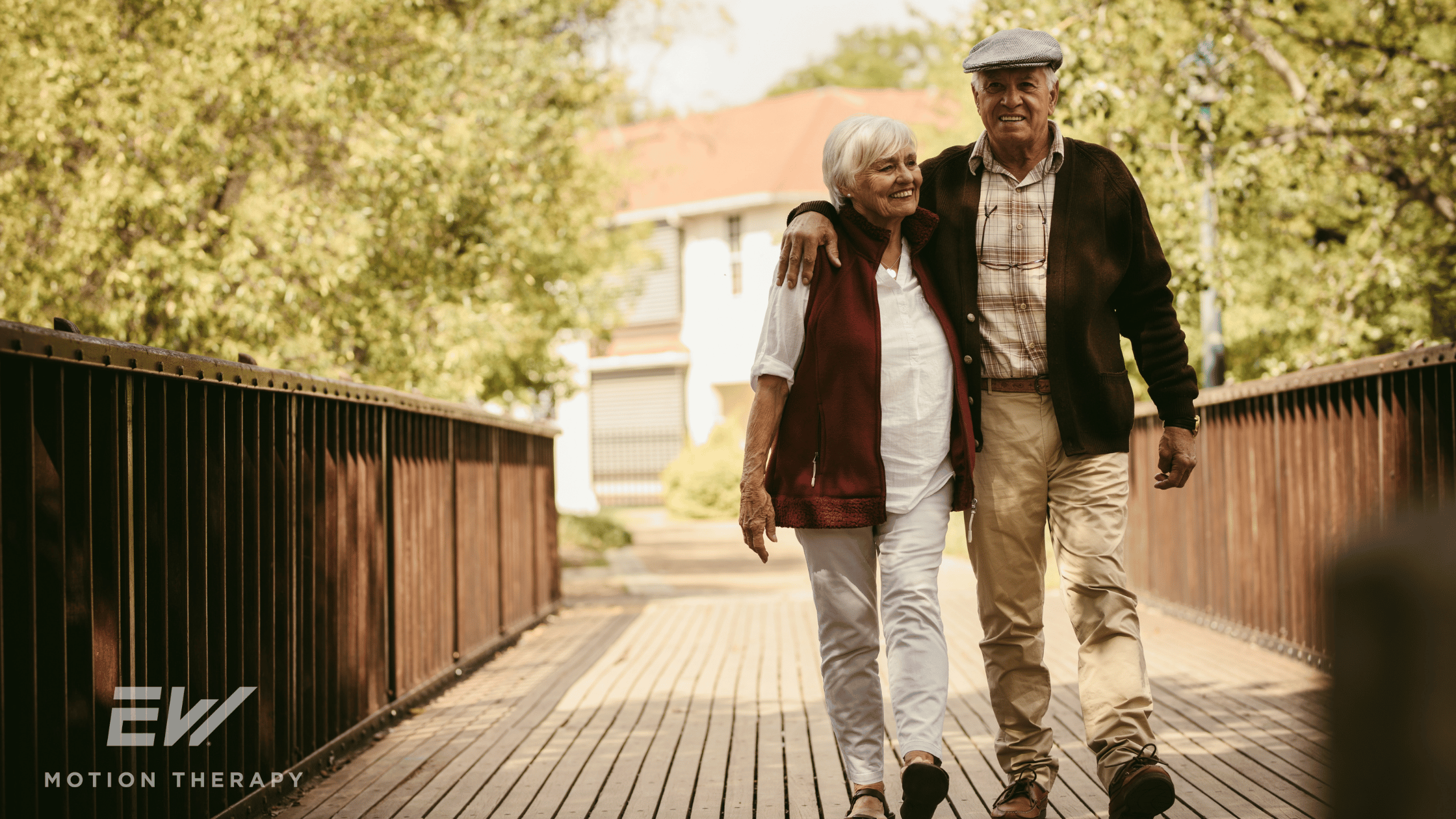The Benefits of Exercise for Arthritis: Enhancing Mobility and Reducing Pain

Licensed Physical Therapist, PT, DPT // EW Motion Therapy Homewood
Arthritis is a common condition that affects millions of people worldwide, causing pain, stiffness, and swelling in the joints. While it might seem counterintuitive to exercise when experiencing joint pain, regular physical activity is one of the most effective ways to manage arthritis symptoms. Exercise can improve joint function, increase flexibility, and reduce pain, making it easier for individuals with rheumatoid arthritis or osteoarthritis to carry out their daily activities.
Physical therapy plays a pivotal role in managing arthritis, offering pain relief and facilitating safe and effective exercise. At EW Motion Therapy, we take pride in assisting our clients with arthritis to move safely, reduce pain, and maintain their independence. Even if our services are not a perfect fit for you, this article will still be beneficial as we delve into the advantages of exercise for arthritis, address safety concerns, and provide specific exercises for knee, hip, and shoulder arthritis. We will also underscore the role of physical therapy in promoting safe and effective exercise for those with arthritis.
The power of exercise: a game changer for arthritis
Improved joint mobility and flexibility
Regular exercise helps maintain and improve the range of motion in affected joints. By keeping the joints moving, individuals can prevent stiffness and improve their overall mobility. Stretching exercises, in particular, can help lengthen muscles around the joints, providing better support and reducing the risk of injury.
Pain reduction
Exercise is a natural pain reliever for arthritis. It triggers the release of endorphins, the body's natural painkillers, which can significantly reduce the perception of pain and enhance overall well-being. Moreover, regular physical activity can help curb inflammation and swelling in the joints, providing further relief from pain.
Enhanced muscle strength
Strengthening the muscles around the affected joints can provide better support and stability, reducing the strain on the joints themselves. This is particularly important for weight-bearing joints like the knees and hips. Stronger muscles can help distribute weight more evenly, reducing the pressure on the joints and minimizing pain.
Improved overall health
Regular exercise has numerous health benefits beyond arthritis management. It can improve cardiovascular health, boost mood and mental health, enhance sleep quality, and increase energy levels. These overall health improvements can contribute to a better quality of life for individuals with arthritis.
Safety considerations for exercising with arthritis
Before starting any exercise program, it is essential to consult a healthcare professional, such as a doctor or physical therapist. They can provide personalized recommendations based on the individual's specific condition, overall health, and fitness level. Here are some more tips to consider when exercising with arthritis symptoms.
Start slowly
For those new to exercise or experiencing a flare-up of arthritis symptoms, it is important to start slowly and gradually increase the intensity and duration of exercise. This approach helps the body adapt to new physical activities without causing excessive strain on the joints.
Choose low-impact exercises
Low-impact exercises are gentler on the joints and can be more suitable for individuals with arthritis. Activities such as swimming, cycling, walking, and using an elliptical machine are excellent options. These exercises provide cardiovascular benefits without putting too much stress on the joints.
Warm up and cool down
Warming up before exercise and cooling down afterward are crucial steps to prevent injury and reduce stiffness. A proper warm-up increases blood flow to the muscles and joints, preparing them for activity. Cooling down helps gradually lower the heart rate and prevents muscle stiffness after exercise.
Listen to your body
It is essential to listen to your body and avoid pushing through pain. While some discomfort during exercise is normal, sharp or severe pain is a signal to stop and rest. Adjusting the intensity or type of exercise can help avoid exacerbating arthritis symptoms. Additionally, be sure to discuss any new exercise regimen with your healthcare provider.
Example exercises for knee, hip, and shoulder arthritis
Knee arthritis exercises
Wall sits: Begin standing tall a step in front of a wall. Place your back against the wall, then slide your body down into a seated or squat position. Hold. Imagine you are sitting in an invisible chair. Be sure your feet are directly under your knees and your knees are bent to a 90-degree angle.

Sit-to-stand: Begin sitting upright with your feet flat on the ground underneath your knees. Move your shoulders and head over your toes, bring your knees forward, and allow your hips to come off the chair, then push down equally into both feet to stand up. Sit back down and repeat. Make sure to keep your weight evenly distributed between both legs, and try to keep your back straight throughout the exercise. Do not lock out your knees once you are standing.

Seated long arc quads: Begin sitting upright in a chair. Slowly straighten one knee so that your leg is straight out in front of you. Hold, and then return to starting position and repeat. Make sure to keep your back straight during the exercise.

Supine bridge: Begin lying on your back with your arms resting at your sides, your legs bent at the knees and your feet flat on the ground. Tighten your abdominals and slowly lift your hips off the floor into a bridge position, keeping your back straight. Make sure to keep your trunk stiff throughout the exercise and your arms flat on the floor.

Hip arthritis exercises
Clamshells: Begin lying on your side with your knees bent and your hips and shoulders stacked. Engage your abdominals and raise your top knee up toward the ceiling, then slowly return to the starting position and repeat. Make sure to keep your core engaged and do not roll your hips forward or backward during the exercise.

Straight leg raise: Begin lying on your back with one leg bent and your opposite leg straight. Keeping your leg straight, raise your leg up until your thigh is at the same height of your bent knee. Slowly return to the starting position and repeat. Make sure to not let your leg or pelvis rotate to either side and do not arch your back.

Banded side steps: Begin standing upright with a resistance band looped around your thighs, just above your knees. Bend your knees slightly so you are in a mini squat position. Slowly step sideways, maintaining tension in the band. Make sure to keep your feet pointing straight forward and do not let your knees collapse inward during the exercise.

Shoulder arthritis exercises
Standing rows with resistance: Begin in a standing upright position holding both ends of a resistance band that is anchored in front of you at chest height. Pull your arms back against the resistance, bending your elbows, then slowly return to the starting position and repeat. Make sure to keep your back straight and think of squeezing your shoulder blades together as you pull your arms back.

Standing shoulder external rotation with resistance: Begin in a standing upright position holding both ends of a resistance band. Your elbows should be bent at 90 degrees with a towel roll tucked under each arm, and your thumbs pointing outward. Slowly rotate your arms out to the side, then bring them back to the starting position and repeat. Make sure to keep your hips and shoulders facing forward throughout the exercise. Think of squeezing your shoulder blades down and back as you pull your arms outward.

Shoulder internal rotation with resistance: Begin in a standing upright position with your elbow bent at 90 degrees and a towel roll tucked under your arm, holding a resistance band. The anchor point should be on the side closest to your bent arm. Slowly rotate your arm inward. Make sure to keep your hips and shoulders facing forward and maintain a gentle chin tuck throughout the exercise.

Towel wall slides: Begin in a standing upright position holding a towel against a wall at shoulder height. Slowly slide the towel straight up the wall, straightening your elbow. Then lower it back down, and repeat. Make sure to keep your back straight during the exercise and only raise your arm as far as you can without causing pain.

How physical therapy can promote safe exercise
Physical therapy plays a vital role in managing arthritis and promoting safe exercise. A physical therapist can design a personalized exercise program tailored to the individual's specific needs and limitations. They can teach proper techniques to avoid injury and maximize the benefits of exercise. Here are some ways physical therapy can help:
Personalized exercise programs
A physical therapist will assess the individual's condition, pain levels, and overall fitness to create a customized exercise plan. This plan will include specific exercises that target the affected joints, improve strength and flexibility, and address any imbalances or weaknesses.
Education and guidance
Physical therapists educate individuals about their condition and how to manage it effectively. They provide guidance on proper body mechanics, posture, and techniques to avoid joint stress during daily activities and exercise. This education empowers individuals to take an active role in managing their arthritis.
Pain management techniques
Physical therapists can incorporate various pain management techniques into the exercise program. These may include modalities such as heat or cold therapy, ultrasound, and electrical stimulation to reduce pain and inflammation. They can also teach relaxation techniques and breathing exercises to manage pain.
Progress monitoring and adjustments
Regular sessions with a physical therapist allow for ongoing monitoring of progress. The therapist can adjust the exercise program as needed, increasing or decreasing the intensity, adding new exercises, or modifying existing ones based on the individual's response and improvement.
Support and motivation
Working with a physical therapist provides emotional support and motivation. They can help individuals stay committed to their exercise program, providing encouragement and celebrating progress. This support can be especially valuable during challenging times when arthritis symptoms may flare up.
Exercise is a powerful tool for managing arthritis and improving quality of life. By incorporating regular physical activity into their routine, individuals with arthritis can experience reduced pain, improved joint function, and enhanced overall health. It is essential to approach exercise with caution, following safety guidelines and seeking guidance from healthcare professionals, such as physical therapists. With the right approach, exercise can become a cornerstone of arthritis management, helping individuals lead more active and fulfilling lives. Returning to healthy movement is the ultimate goal we have for our patients at EW Motion Therapy - your condition does not define what you can accomplish. To learn more about what physical therapy might cost you, click the button below to download our free pricing guide.


